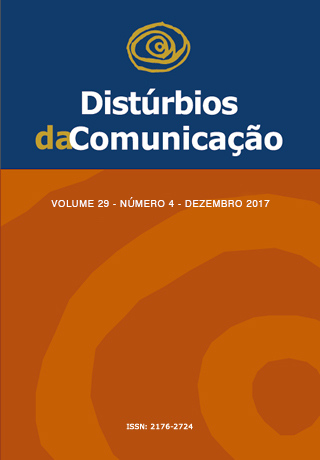Auditory-perceptive analysis and self-perception of the voice in evangelical pastors
DOI:
https://doi.org/10.23925/2176-2724.2017v29i4p692-701Keywords:
Speech therapy, Voice, Religious, Voice disorders.Abstract
Objective: verify the association between vocal quality and vocal complaint with variables, gender, age, ministry time, working hours, vocal parameters and vocal self-perception in evangelical pastors. Method: descriptive, analytical study of cross - sectional design. Sample of 52 religious, aged 20 to 69 years; 38 men and 14 women, average of 8 hours of work, between 1 and 32 years of ministry. Pastors were included, between 20 and 69 years in ministerial exercise and excluded stutterers or those who had a cold. Procedures: recording the voices of the participants, with the sustained vowel / a /, the days of the week and the reading of a random excerpt from the book of psalms of the Holy Bible. Then three speech therapists, specialists in voice and by consensus performed auditory perceptive analysis of the voice. There was also a questionnaire with identification of sociodemographic data and self-perception of the voice and aspects of speech in public. Descriptive data analysis and the Pearson Qui Quadrado and Fisher Exact association tests were performed. The level of significance was set at p≤0.05 (5%). Results: vocal quality was assessed as altered in 47.2% of the sample, with slight alteration degree of 41.5%. The other vocal parameters pitch, articulation, loudness, resonance and speech velocity were considered adequate in most of the sample. 78.85% of the pastors showed a good self-perception of speech in public, 52% self-perceived the voice as reasonable and most 76.9% reported vocal complaints of tiredness and hoarseness after voice use, almost all pastors (92, 5%) said they are able to maintain attention and influence the listener when speaking in public. There was an association of vocal complaints with the male gender (p <0.001), age range of 39 to 58 years (p <0.001) and professionals using the voice from 5 to 8 hours per day (p <0.001). The other variables were not associated with the complaints. There was an association of altered vocal quality (p <0.034) with age ranging from 39 to 58 years, degree of mild vocal alteration (p <0.001) with altered resonance (p <0.001), pitch (p <0.003) and self-perception of speech in public (p <0.001) adequate. Conclusion: most evangelical pastors report vocal complaints of vocal fatigue and hoarseness, after the use of professional voice, more incident in males, between 39 and 58 years, in pastors who use the voice from 5 to 8 hours a day . Almost half of them present altered voice quality, associated with this same age group, with altered resonance. Pitch and self-perception of speech in public adequateDownloads
Download data is not yet available.
Downloads
Published
2017-12-27
Issue
Section
Artigos
License
Copyright (c) 2017 Fernanda Bernadeth de Souza, Anna Carolina Ferreira Marinho, Letícia Caldas Teixeira

This work is licensed under a Creative Commons Attribution 4.0 International License.









